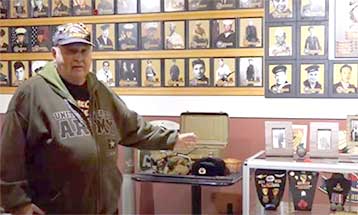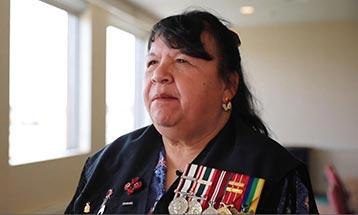The idea behind this exhibit was inspired by a conversation between two Veterans in 2015.
Ray Deer and a fellow Veteran, Peter Jacobs wanted to create something to honour local Mohawk Veterans who had served in the Canadian Armed Forces and the United States military. “We have a large Veteran population in our community. Before many of them passed on, we wanted to do something to show our appreciation for their sacrifices,” says Deer.
“Lots of people began reaching out because they did not know what to do with military mementos from family members.”
Deer and Jacobs decided to create an exhibit displaying military artifacts belonging to those who had served. As word got out, the phone calls came in. “Lots of people began reaching out because they did not know what to do with military mementos from family members.” As the exhibit started to grow with more and more items, Deer and Jacobs coordinated visits to local schools so that students could engage with the collection.
Many of the artifacts have been donated by local Veterans and their families, including uniforms, medals, and other keepsakes, such as timecards from the Second World War. One of the exhibit’s most unique pieces is an Iroquois war club from the 1812 era. “We had an individual within our Legion branch that was heavily involved in the history of the War of 1812. This was quite the discovery,” recalls Deer.
The exhibit has travelled to different schools and community centres over the years. The travelling cases Deer uses are outdated and difficult to transport from location to location. Recently, the Legion applied for funding through the Commemorative Partnership Program to update their equipment to make it easier to transport the artifacts.
The funding they received will also allow them to acquire female mannequins to display the uniforms from women Veterans. “It’s very important for the children and youth to see that women also played an important role during the various conflicts,” says Deer.

Currently, the exhibit is housed within the Legion’s walls due to the COVID-19 pandemic. But once pandemic restrictions are eased, the new resources will allow Deer and his colleagues to continue travelling to share the stories of Indigenous Veterans within their community for years to come.
“When I see curious, young faces looking at the artifacts, it’s a reminder that these sacrifices won’t be forgotten. Because curiosity turns into knowledge.”
Deer’s motivation to keep the exhibit up to date stems from his passion for educating a younger generation. “You know, I’ve done my time… but this project keeps me going. When I see curious, young faces looking at the artifacts, it’s a reminder that these sacrifices won’t be forgotten. Because curiosity turns into knowledge.”
Honouring Canada’s Veterans
Veterans Affairs Canada is committed to honouring those who served Canada during times of war, military conflict and peace, and to keeping the memory of their achievements and sacrifices alive for all Canadians. Funding is available to organizations that undertake commemorative initiatives through the Commemorative Partnership Program.


